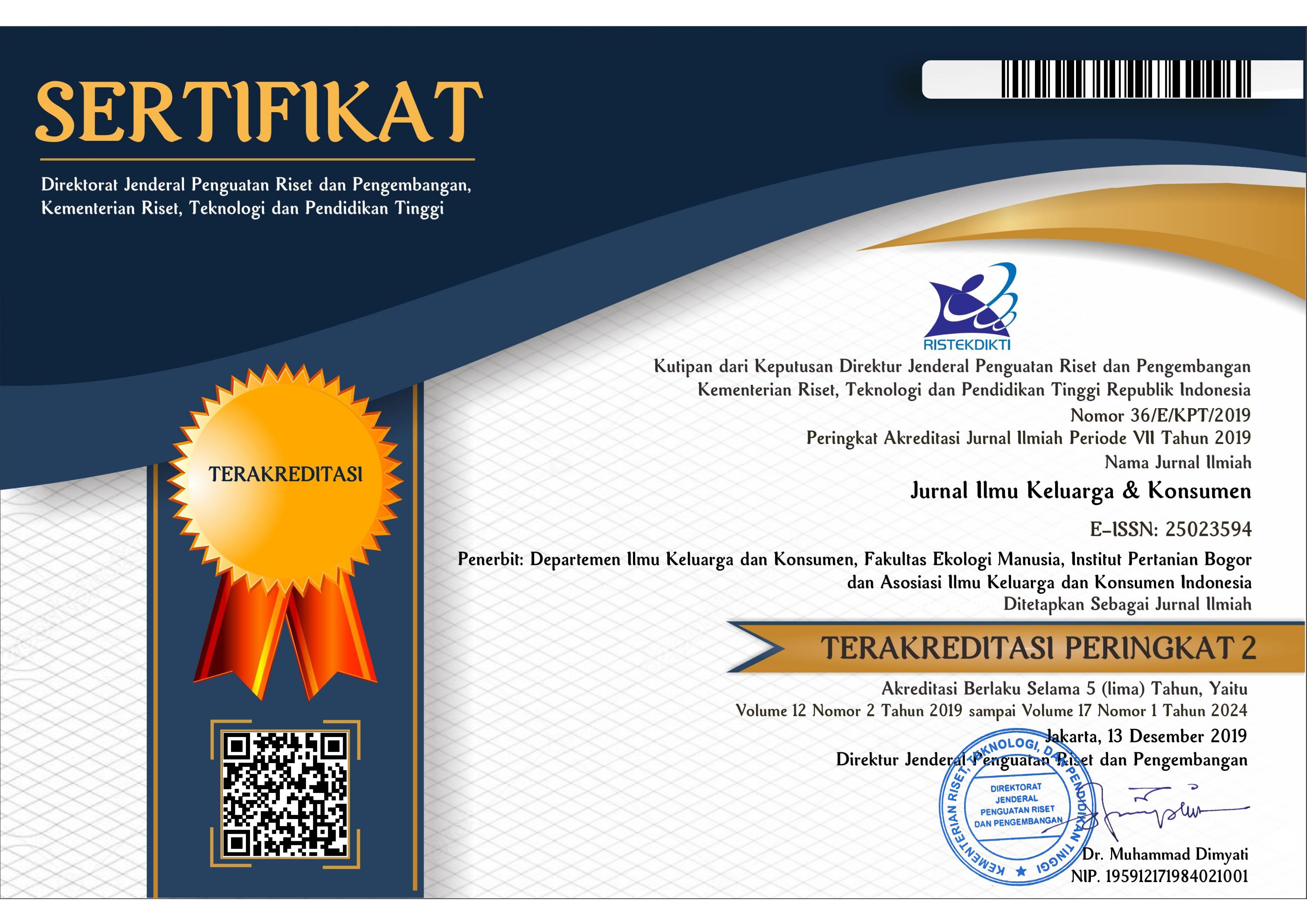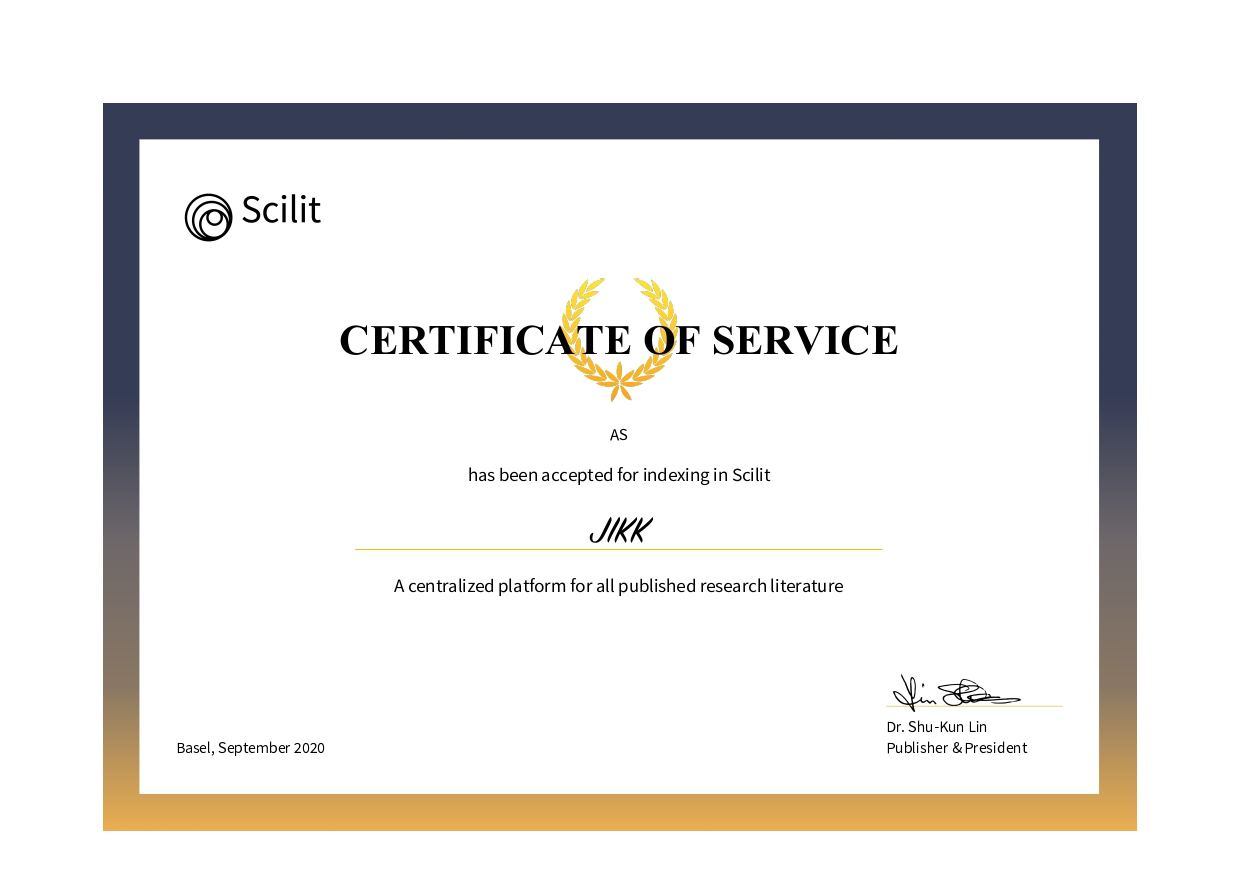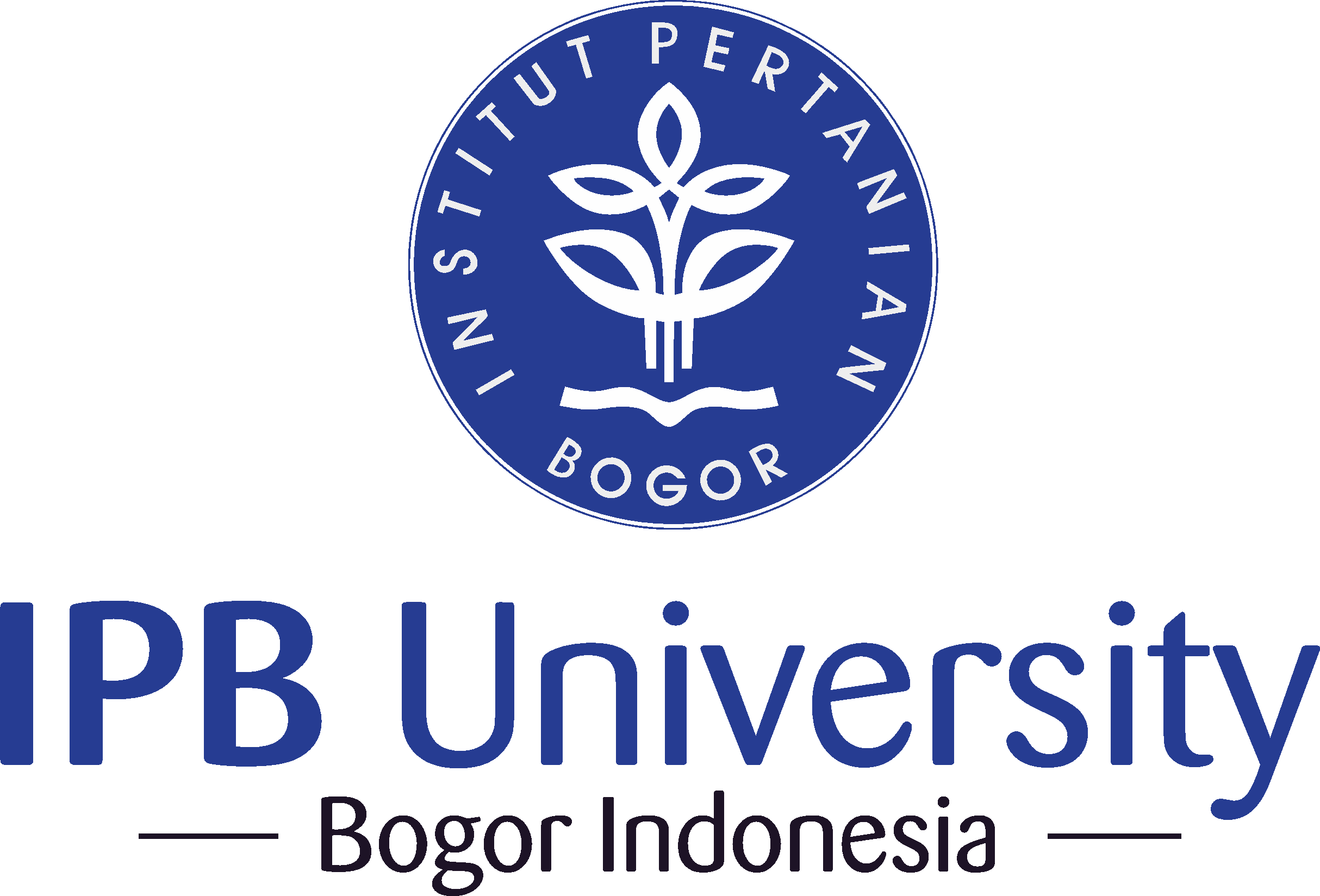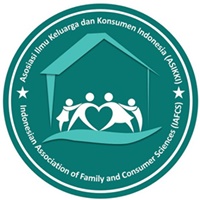ADAPTATION OF THE FAMILY HARDINESS INDEX (FHI) INSTRUMENT FOR INDONESIAN ADOLESCENTS
Alat Ukur Family Hardiness Index (FHI) untuk Remaja Indonesia
Abstract
Family resilience in adolescence measures the ability to cope with challenges and disruptions within the family and engage in positive adaptation in their role as children. To address the limitations of the availability of family resilience measurement tools in the Indonesian language, this study aims to adapt and test the reliability and validity among adolescents. One widely used measurement tool for assessing family resilience internationally is the Family Hardiness Index (FHI), developed as part of The Resilience, Adaptation, and Well-Being Project. The testing was conducted on 276 participants aged 12–17 years (M = 14.5; SD = 1.7), with a gender distribution of 124 males (45%) and 152 females (65%). Psychometric property testing revealed that this adapted instrument met reliability criteria with a Cronbach's alpha value of 0.75 and fulfilled construct validity criteria using confirmatory factor analysis. Through these findings, it is hoped that research related to family resilience for Indonesian adolescents will continue to advance, particularly among families facing various challenges and disruptions. Additionally, multiple suggestions and implications arising from this adaptation are discussed in the concluding section of this article.
References
Ambarwati, R. (2017). Dinamika resiliensi remaja yang pernah mengalami kekerasan orang tua [Dynamics of teenager’s resilience who have experienced violenced from parents]. Psikologika: Jurnal Pemikiran dan Penelitian Psikologi, 22(1), 50–68. https://doi.org/10.20885/psikologika.vol22.iss1.art4
Benty, D. D. N., Mustiningsih, & Maisyaroh. (2020). Characteristics of adolescent problems and problem-solving methods of school heads in the era of disruption. Proceedings of the 1st International Conference on Information Technology and Education (ICITE 2020), 38–43. https://doi.org/10.2991/assehr.k.201214.209
Bethell, C. D., Gombojav, N., & Whitaker, R. C. (2019). Family resilience and connection promote flourishing among US children, even amid adversity. Health Affairs, 38(5), 729–737. https://doi.org/10.1377/hlthaff.2018.05425
Bishop, M., & Greeff, A. P. (2015). Resilience in families in which a member has been diagnosed with schizophrenia. Journal of Psychiatric and Mental Health Nursing, 22(7), 463–471. https://doi.org/10.1111/jpm.12230
Borualogo, I. S., & Jefferies, P. (2019). Adapting the child and youth resilience measure-revised for Indonesian contexts. Journal of Educational, Health and Community Psychology, 8(4), 480. http://doi.org/10.12928/jehcp.v8i4.12962
Chen, J. Y., Yen, M. H., Lin, Y. H., Chen, H. S., Hu, S. H., & Liu, Y. Y. (2015). Predictors of family function in DMD and SMA family. Symbiosis Journal of Nursing & Health Care, 1(1), 1–9. http://doi.org/10.15226/2471-6529/1/1/00109
Chew, J., Carpenter, J., & Haase, A. M. (2018). Young people’s experiences of living with epilepsy: The significance of family resilience. Social Work in Health Care, 57(5), 332–354. https://doi.org/10.1080/00981389.2018.1443195
Choi, H. (2015). Adaptation in families of children with down syndrome: A mixed-methods design. Journal of the Korean Academy of Nursing, 45(5), 501–512. https://doi.org/10.4040/jkan.2015.45.4.501
Deist, M., & Greeff, A. P. (2015). Living with a parent with dementia: A family resilience study. Dementia, 16(1), 126–141. https://doi.org/10.1177/1471301215621853
Detta, B., & Abdullah, S. M. (2017). Dinamika resiliensi remaja dengan keluarga broken home. Insight: Jurnal Ilmiah Psikologi, 19(2), 71. https://doi.org/10.26486/psikologi.v19i2.600
Dewi, R., Efendi, F., Has, E., & Gunawan, J. (2021). Adolescents’ smartphone use at night, sleep disturbance and depressive symptoms. International Journal of Adolescent Medicine and Health, 33(2), 20180095. https://doi.org/10.1515/ijamh-2018-0095
Duca, D. (2015). Family resilience and parental stress: The effects on marital relationship in the context of a child diagnosed with an autism spectrum disorder. Annals of A.I.I. Cuza University Psychology Series, 24(1), 71–90. https://www.psih.uaic.ro/anale-psih/wp-content/uploads/sites/10/2021/01/Family-resilience-and-parental-stress-the-effects-on-marital-relationship-in-the-context-of-a-child-diagnosed-with-an-autism-spectrum-disorder.pdf
Dunst, C. J. (2021). Family hardiness and parent and family functioning in households with children experiencing adverse life conditions: A meta-analysis. International Journal of Psychological Research, 14(2), 93–118. https://doi.org/10.21500/20112084.5236
Everri, M., Messena, M., Nearchou, F., & Fruggeri, L. (2022). Parent-child relationships, digital media use and parents’ well-being during COVID-19 home confinement: The role of family resilience. International Journal of Environmental Research and Public Health, 19(23), 15687. https://doi.org/10.3390/ijerph192315687
Fessler, D. M. T., Holbrook, C., Pollack, J. S., & Hahn-Holbrook, J. (2014). Stranger danger: Parenthood increases the envisioned bodily formidability of menacing men. Evolution and Human Behavior, 35(2), 109–117. https://doi.org/https://doi.org/10.1016/j.evolhumbehav.2013.11.004
Finklestein, M., Pagorek-Eshel, S., & Laufer, A. (2022). Adolescents’ individual resilience and its association with security threats, anxiety and family resilience. Journal of Family Studies, 28(3), 1023–1039. https://doi.org/10.1080/13229400.2020.1778504
Fong, V., Gardiner, E., & Iarocci, G. (2021). Satisfaction with informal supports predicts resilience in families of children with autism spectrum disorder. Autism, 25(2), 452–463. https://doi.org/10.1177/1362361320962677
Gralton, K. S. (2017). Exploring resiliency and family functioning for families of premature infants [Doctoral dissertation, University of Wisconsin Milwaukee]. UWM Digital Commons. https://dc.uwm.edu/etd/1629.
Greeff, A. P., & Lawrence, J. (2012). Indications of resilience factors in families who have lost a home in a shack fire. Journal of Community & Applied Social Psychology, 22(3), 210–224. https://doi.org/https://doi.org/10.1002/casp.1108
Greeff, A. P., Vansteenwegen, A., & Geldhof, A. (2014). Resilience in families with a child with cancer. Pediatric Hematology and Oncology, 31, 670–679. https://doi.org/10.3109/08880018.2014.905666
Harrist, A. W., Henry, C. S., Liu, C., & Morris, A. S. (2019). Family resilience: The power of rituals and routines in family adaptive systems. In B. H. Fiese, M. Celano, K. Deater-Deckard, E. N. Jouriles, & M. A. Whisman (Eds.), APA handbook of contemporary family psychology: Foundations, methods, and contemporary issues across the lifespan (pp. 223–239). American Psychological Association. https://doi.org/10.1037/0000099-013
Hayatini, D. R., & Dimyati, D. (2020). Validity and reliability of resilience scale for Islamic boarding school students. Humaniora, 11(3), 227–233. https://doi.org/10.21512/humaniora.v11i3.6693
Herbell, K., Breitenstein, S. M., Melnyk, B. M., & Guo, J. (2020). Family resilience and flourishment: Well-being among children with mental, emotional, and behavioral disorders. Research in Nursing & Health, 43(5), 465–477. https://doi.org/https://doi.org/10.1002/nur.22066
Hu, L., & Bentler, P. M. (1999). Cutoff criteria for fit indexes in covariance structure analysis: Conventional criteria versus new alternatives. Structural Equation Modeling, 6(1), 1–55. https://doi.org/10.1080/10705519909540118
Kaplan, R.M. & Saccuzzo, D.P. (2005) Psychological testing principles: Application and issue (6th ed.). Wadsworth.
MacPhee, D., Lunkenheimer, E., & Riggs, N. (2015). Resilience as regulation of developmental and family processes. Family Relations, 64(1), 153–175. https://doi.org/https://doi.org/10.1111/fare.12100
Masten, A. S. (2016). Resilience in developing systems: The promise of integrated approaches. European Journal of Developmental Psychology, 13(3), 297–312. https://doi.org/10.1080/17405629.2016.1147344
Maurović, I., Liebenberg, L., & Ferić, M. (2020). A Review of family resilience: Understanding the concept and operationalization challenges to inform research and practice. Child Care in Practice, 26(4), 337–357. https://doi.org/10.1080/13575279.2020.1792838
McCubbin Resilience. (2016). Measures. Retrieved November 29, 2023, from https://www.mccubbinresilience.org/measures.html
McCubbin, H. I., McCubbin, M. A. (1988) Typologies of resilient families: Emerging roles of social class and ethnicity. Family Relations, 37(3), 247–254. https://doi.org/10.2307/584557
McCubbin, H. I., Thompson, A. I., & McCubbin, M. A. (1996). Family assessment: Resiliency, coping and adaptation-Inventories for research and practice (pp. 823–841). University of Wisconsin System.
McStay, R. L., Trembath, D., & Dissanayake, C. (2014). Stress and family quality of life in parents of children with autism spectrum disorder: Parent gender and the double ABCX model. Journal of Autism and Developmental Disorders, 44(12), 3101–3118. https://doi.org/10.1007/s10803-014-2178-7
Nunnally, J. C., & Bernstein, I. H. (1994). Psychometric theory (3rd ed.). McGraw-Hill.
Park, M., Choi, E. K., Lyu, C. J., Han, J. W., & Hahn, S. M. (2022). Family resilience factors affecting family adaptation of children with cancer: A cross-sectional study. European Journal of Oncology Nursing, 56, 102078. https://doi.org/10.1016/j.ejon.2021.102078
Persson, C., Benzein, E., & Årestedt, K. (2016). Assessing family resources: Validation of the Swedish version of the Family Hardiness Index. Scandinavian Journal of Caring Sciences, 30(4), 845–855. https://doi.org/https://doi.org/10.1111/scs.12313
Puspita, J. N. (2011). The description of family resiliency in family who have child with cancer [Unpublished thesis]. Universitas Indonesia.
Putu, D., & Putu, W. B. I. G. A. (2023). Faktor-faktor yang memengaruhi resiliensi remaja pasca dating violence: Sebuah studi literatur [Factors influencing adolescent post-dating violence resilience: A literature study]. Humanitas (Jurnal Psikologi), 7(1), 113–124. https://doi.org/10.28932/humanitas.v7i1.6086
Qiu, Y., Xu, L., Pan, Y., He, C., Huang, Y., Xu, H., Lu, Z., & Dong, C. (2021). Family resilience, parenting styles and psychosocial adjustment of children with chronic illness: A cross-sectional study. Frontiers in Psychiatry, 12(May), 1–10. https://doi.org/10.3389/fpsyt.2021.646421
Ramdani, R., Hanurawan, F., Ramli, M., Lasan, B. B., & Afdal, A. (2020). Development and validation of indonesian academic resilience scale using rasch models. International Journal of Instruction, 14(1), 105–120. https://doi.org/10.29333/IJI.2021.1417A
Rofiqah, Rosidi, S., & Pawelzick, C. A. (2023). Personal and social factors of resilience: Factorial validity and internal consistency of Indonesian Read. International Journal of Advanced Psychiatric Nursing, 5(1), 113–120. https://doi.org/10.33545/26641348.2023.v5.i1b.119
Saetes, S., Hynes, L., McGuire, B. E., & Caes, L. (2017). Family resilience and adaptive coping in children with juvenile idiopathic arthritis: Protocol for a systematic review. Systematic Reviews, 6(1), 221. https://doi.org/10.1186/s13643-017-0619-z
Salamah, A., Sunarti, E., & Riany, Y. E. (2023). Pengaruh tipologi keluarga dan lingkungan ramah keluarga terhadap resiliensi dewasa awal pada masa pandemi Covid-19 [Effect of family typology and family-friendly environment onearly adult resilience during Covid-19 pandemic]. Jurnal Ilmu Keluarga dan Konsumen, 16(3), 199–212. https://doi.org/10.24156/jikk.2023.16.3.199
Sari, D., Rejekiningsih, T. & Muchtarom, M. (2020). Students' digital ethics profile in the era of disruption: An overview from the internet use at risk in Surakarta City, Indonesia. International Association of Online Engineering. https://www.learntechlib.org/p/216559/
Sunarti, E., Islamia, I., Rochimah, N., & Ulfa, M. (2017). Pengaruh faktor ekologi terhadap resiliensi remaja [The influence of ecological factors on youth resiliency]. Jurnal Ilmu Keluarga dan Konsumen, 10(2), 107–119. https://doi.org/10.24156/jikk.2017.10.2.107
Taherdoost, H. (2016). Validity and reliability of the research instrument; How to test the validation of a questionnaire/survey in a research. International Journal of Academic Research in Management (IJARM), 5(3), 28–36. https://doi.org/10.2139/ssrn.3205040
Ungar, M. (2016). Varied patterns of family resilience in challenging contexts. Journal of Marital and Family Therapy, 42, 19–31. https://doi.org/10.1111/jmft.12124
Van Schoors, M., Caes, L., Verhofstadt, L. L., Goubert, L., & Alderfer, M. A. (2015). Systematic review: Family resilience after pediatric cancer diagnosis. Journal of Pediatric Psychology, 40(9), 856–868. https://doi.org/10.1093/jpepsy/jsv055
Wardhani, R. H., & Sunarti, E. (2017). Ancaman, faktor protektif, aktivitas, dan resiliensi remaja: Analisis berdasarkan tipologi sosiodemografi [Hazard, protective factors, activities, and resiliency of adolescent: Analysis based on sociodemographic typology]. Jurnal Ilmu Keluarga dan Konsumen, 10(1), 47–58. https://doi.org/10.24156/jikk.2017.10.1.47
Weeland, J., Helmerhorst, K. O. W., & Lucassen, N. (2021). Understanding differential effectiveness of behavioral parent training from a family systems perspective: Families are greater than “some of their parts.” Journal of Family Theory & Review, 13(1), 34–57. https://doi.org/https://doi.org/10.1111/jftr.12408
Yuliani, S., Widianti, E., & Sari, S. P. (2018). Resiliensi remaja dalam menghadapi perilaku bullying [Adolescent resilience in facing bullying behavior]. Jurnal Keperawatan BSI, 6(1), 77–86. https://ejauornal.bsi.ac.id/ejournal/index.php/jk/article/view/3756
Copyright (c) 2024 Jurnal Ilmu Keluarga dan Konsumen

This work is licensed under a Creative Commons Attribution-ShareAlike 4.0 International License.
Authors submitting manuscripts should understand and agree that copyright of manuscripts published are held Jurnal Ilmu Keluarga dan Konsumen. The statement to release the copyright to Jurnal Ilmu Keluarga dan Konsumen is stated in Copyright Release Form. Copyright encompass exclusive rights to reproduce, to distribute, and to sell any part of the journal articles in all form and media. The reproduction of any part of this journal is allowed with a written permission from Jurnal Ilmu Keluarga dan Konsumen.










